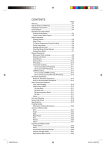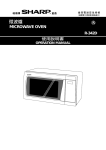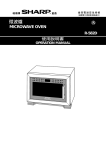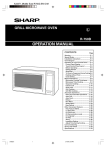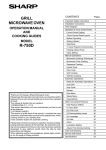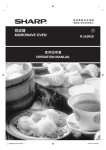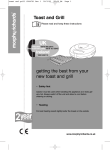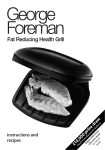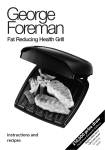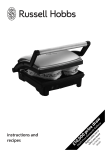Download Sharp R-142D Specifications
Transcript
R MICROWAVE OVEN R-142D(B)/(R)/(W)/(K)/(P) OPERATION MANUAL AND COOKBOOK RECIPES SHARP INSTANT COOK/STA RT STOP/CLE AR CONTENTS Page 1B Warning ......................................................... E-1 Special Notes ................................................ E-2 Installation Instructions ............................... E-3 Oven Diagram ............................................... E-3 Operation of Touch Control Panel Control Panel Display ................................. E-4 Touch Control Panel Layout ...................... E-4 Before Operating Getting Started ........................................... E-5 Clock Setting ............................................... E-5 Stop/Clear ................................................... E-5 To Cancel a Programme During Cooking ..... E-5 Microwave Cooking Techniques ................. E-6 Manual Operations Microwave Time Cooking .......................... E-7 Instant Cook ................................................ E-7 Increasing Time During the Cooking Programme ............... E-8 Slow Cook ................................................... E-9 Slow Cook Recipes ................................... E-10 Automatic Operations Notes for Automatic Operations ............. E-12 Auto Cook ................................................. E-12 Auto Cook Menu Guide ........................... E-13 Defrost ....................................................... E-15 Defrost Menu Guide ................................. E-16 Other Convenient Features Child Lock .................................................. E-17 Alarm ......................................................... E-17 Care and Cleaning ...................................... E-18 Service Call Check ...................................... E-18 Specifications ............................................. E-18 Cookbook Recipes ..................................... 1-B WARNING Read all instructions before using the appliance. 1. To reduce the risk of fire in the oven cavity: a. Do not overcook food. b. Remove wire twist-ties from paper or plastic bags before placing bag in the oven. c. Do not heat oil or fat for deep frying. The temperature of the oil cannot be controlled. d. After use wipe the waveguide cover with a damp cloth, followed by a dry cloth to remove any food splashes and grease. Built-up grease may overheat and begin to cause smoke or catch fire. e. If materials inside the oven should smoke or ignite, keep oven door closed, turn oven off, and disconnect the power cord, or shut off power at the fuse or circuit breaker panel. f. Attend the oven closely when using disposable containers made from plastic, paper or other combustible material. 2. To reduce the risk of explosion and sudden boiling: a. Do not place sealed containers in the oven. Baby bottles fitted with a screw cap or teat are considered to be sealed containers. b. When boiling liquids in the oven, use the wide-mouthed container and stand about 20 seconds at the end of cooking to avoid delayed eruptive boiling of liquids. 3. This oven is for home food preparation only and should only be used for heating, cooking and defrosting food and beverage. It is not suitable for commercial or laboratory use. 4. Never operate the oven whilst any object is caught or jammed between the door and the oven. 5. Do not try to adjust or repair the oven yourself because of hazard. The oven must be adjusted or repaired by a qualified service technician trained by SHARP. 6. Do not operate the oven if it is not working correctly or damaged until it has been repaired by a qualified service technician trained by SHARP. It is particularly important that the oven door closes properly and that there is no damage to: (1) Door (warped), (2) Hinges and Latches (broken or loosened), (3) Door Seals and Sealing Surfaces. 7. Do not catch the utensil, your clothes or accessories on the door safety latches when you take out the food from the oven. 8. Should the power supply cord become damaged, it must be replaced with a special cord supplied or approved by the SHARP SERVICE CENTRE. And it must be replaced by a qualified service technician trained by SHARP. 9. Make sure that the power supply cord is undamaged, and that it does not run under the oven or over any hot surface or sharp edges. 10. If the oven lamp fails please consult your dealer or a qualified service technician trained by SHARP. 11. After cooking, use oven mittens when taking out the food and avoid steam burns by directing steam away from the face and hands. 12. Slowly lift the furthest edge of dish’s cover and microwave plastic wrap and carefully open popcorn and oven cooking bags away from the face. 13. To prevent the turntable from breaking: a. Before cleaning the turntable with water, leave the turntable to cool. b. Do not put hot foods or hot utensils on the cold turntable. c. Do not put cold foods or cold utensils on the hot turntable. 14. Do not place anything on the outer cabinet. 15. Make sure the utensil does not touch the interior walls during cooking. 16. Do not store food or any other items inside the oven. 17. This appliance is not intended for use by young children or infirm persons without supervision. 18. Only allow children to use the oven without supervision when adequate instructions have been given so that the child is able to use the oven in a safe way and understands the hazards of improper use. 19. Young children should be supervised to ensure that they do not play with the appliance. E–1 SPECIAL NOTES DO DON’T Eggs, fruits, nuts, seeds, vegetables, sausages and oysters * Puncture egg yolks and whites and oysters before cooking to prevent “explosion”. * Pierce skins of potatoes, apples, squash, hot dogs, sausages and oysters so that steam escapes. * Cook eggs in shells. This prevents “explosion”, which may damage the oven or injure yourself. * Reheat whole eggs. * Overcook oysters. * Dry nuts or seeds in shells. Popcorn * Use specially bagged popcorn for the microwave oven. * Listen while popping corn for the popping to slow to 1-2 seconds. * Pop popcorn in regular brown bags or glass bowls. * Exceed maximum time on popcorn package. Baby food * Transfer baby food to small dish and heat carefully, stirring often. Check for suitable temperature to prevent burns. * Remove the screw cap and teat before warming baby bottles. After warming shake thoroughly. Check for suitable temperature. * Heat disposable bottles. * Overheat baby bottles. Only heat until warm. * Heat bottles with nipples on. * Heat baby food in original jars. General * Food with filling should be cut after heating, to release steam and avoid burns. * Stir liquids briskly before and after cooking for even heating. * Use a deep bowl when cooking liquids or cereals to prevent boiling over. * For boiling or cooking liquids see WARNING on page E-1. * Heat or cook in closed glass jars or air tight containers. * Deep fry fat. * Dry wood, herbs, or wet papers. * Operate the oven empty. Canned foods * Remove food from can. * Heat or cook food while in cans. Sausage rolls, Pies, Christmas pudding * These foods have high sugar and/or fat contents. * Cook for the recommended time. * Overcook as they may catch fire. Meats * Use a microwave proof rack or plate to collect drained juices. * Place meat directly on the turntable for cooking. Utensils * Check the utensils are suitable for MICROWAVE cooking before you use them. * Use metal utensils for MICROWAVE cooking. Metal reflects microwave energy and may cause an electrical discharge known as arcing. Aluminium foil * Use to shield food to prevent over cooking. * Watch for sparkling, therefore reduce foil and keep clear of cavity walls. * Use too much. * Shield food close to cavity walls as sparkling can damage the oven. E–2 INSTALLATION INSTRUCTIONS 1. Remove all packing materials from the oven cavity and the feature sticker from the oven door panel (if available). Check the unit for any damage, such as a misaligned door, damaged door seals around the door or dents inside the oven cavity or on the door. If there is any damage, please do not operate the oven until it has been checked by the SHARP SERVICE CENTRE and repaired, if necessary. 2. Accessories provided 1) Turntable 2) Roller Stay 3) Operation Manual and Cookbook Recipes 3. Fit the roller stay and turntable referring to OVEN DIAGRAM below. Place the roller stay on the bottom of oven and seat the turntable on the roller stay, while aligning well with the coupling in the centre. NEVER use the oven without the turntable and roller stay. 4. The oven should not be installed in any area where heat and steam are generated, for example, next to a conventional oven unit. The oven should be installed so as not to block ventilation openings. Allow space of at least 15cm from top of the oven for air ventilation. This oven is not designed to be built-in to a wall or cabinet. 5. Neither the manufacturer nor the distributors can accept any liability for damage to the machine or personal injury for failure to observe the correct electrical connecting procedure. The A.C. voltage and frequency must correspond to the one indicated on the rating plate on the back of the oven. 6. This appliance must be earthed: IMPORTANT The wires in power supply cord are coloured in accordance with the following code: Green-and-yellow : Earth Blue : Neutral Brown : Live As the colours of the wires in the power supply cord of this appliance may not correspond with the coloured marking identifying the terminals in your plug, proceed as follows: The wire which is coloured green-and-yellow must be connected to the terminal in the plug which is marked with the letter E or by the earth symbol or coloured green or green-and-yellow. The wire which is coloured blue must be connected to the terminal which is marked with the letter N or coloured blue. The wire which is coloured brown must be connected to the terminal which is marked with the letter L or coloured brown. OVEN DIAGRAM 10 9 8 7 11 6 14 12 1 2 3 5 2 15 4 1. Door handle 2. Door safety latches 3. Door 4. Door seals and sealing surfaces 5. Coupling 6. Oven lamp 7. Touch control panel (see page E-4) 8. Waveguide cover (Do not remove) 9. Digital readout 10. Door hinges 11. Ventilation openings 12. Power supply cord 13. Rating plate 14. Turntable 15. Roller stay E–3 13 OPERATION OF TOUCH CONTROL PANEL The operation of the oven is controlled by pressing the appropriate pads arranged on the surface of the control panel. An entry signal tone should be heard each time you press the control panel to make a correct entry. In addition an audible signal will sound for approximately 2 seconds at the end of the cooking cycle, or 4 times when cooking procedure is required. Control Panel Display Indicator COOK DEF KG QTY CHECK Touch Control Panel Layout 1 2 2 STOP/CLEAR 3 4 SLOW COOK DEFROST AUTO COOK QUANTITY CLOCK 8 5 6 7 1 INSTANT COOK/START PAD •Press to start oven after setting programmes. •Press once to cook for 1 minute at 100% (HIGH POWER) or increase by 1 minute multiples each time this pad is pressed during cooking. 3 SLOW COOK PAD Press to cook slowly and longer time. 2 STOP/CLEAR PAD •Press to clear during programming. •Press once to stop operation of oven during cooking; press twice to cancel cooking programme. 5 CLOCK PAD Press to set clock or child lock. 4 DEFROST PAD Press to defrost meat by entering the defrosting time. 7 TIME PADS Press to enter cooking/ defrosting time or clock time. 8 AUTO COOK PAD Press to select the AUTO COOK menu. 6 QUANTITY PAD Press to enter the quantity for AUTO COOK menus. NOTE: Open the door to programme the oven. INSTANT COOK/START pad can be used only when the door is closed. E–4 BEFORE OPERATING Getting Started Step 1 Procedure Pad Order Display Ensure the oven door is closed. Plug the oven into a power point. Flashing four eights. 2 Press the STOP/CLEAR pad (a beep sound can be heard). Only the dots will remain. Clock Setting * To enter the present time of day e.g. 11:34 (AM or PM). Step Procedure Pad Order Display Open the door and press the CLOCK pad. 1 2 CLOCK Enter the hours by pressing the TIME pads. x1 x1 Press the CLOCK pad again. 3 4 CLOCK Enter the minutes by pressing the TIME pads. x3 x4 Press the CLOCK pad again. 5 CLOCK This is a 12 hour clock. The clock of the oven works based on the frequency of power source. So it may gain or lose in some area where the frequency varies. It is recommended that you should adjust the time occasionally. Stop/Clear Press the STOP/CLEAR pad once to: 1. Stop the oven temporarily during cooking. 2. Clear if you make a mistake during programming. To Cancel a Programme During Cooking Press the STOP/CLEAR pad twice. E–5 MICROWAVE COOKING TECHNIQUES Arrange food carefully Place thickest areas toward outside of dish. Watch cooking time Cook for the shortest amount of time indicated and add more time as needed. Food severely over-cooked can smoke or ignite. Cover foods before cooking Check recipe for suggestions: paper towels, microwave plastic wrap or a lid. Covers prevent spattering and help foods to cook evenly. (Helps keep oven clean) Shield foods Use small pieces of aluminium foil to cover thin areas of meats or poultry in order to avoid overcooking. Stir foods From outside to center of dish once or twice during cooking, if possible. Turn foods Foods such as chicken, hamburgers or steaks should be turned over once during cooking. Rearrange foods Like meatballs halfway through cooking both from top to bottom and from the center of the dish to the outside. Allow standing time After cooking ensure adequate standing time. Remove food from oven and stir if possible. Cover for standing time which allows the food to finish cooking without overcooking. Check for doneness Look for signs indicating that cooking temperature has been reached. Doneness signs include: – Food steams throughout, not just at edge. – Poultry thigh joints move easily. – Pork and poultry show no pinkness. – Fish is opaque and flakes easily with a fork. Condensation A normal part of microwave cooking. The humidity and moisture in food will influence the amount of moisture in the oven. Generally, covered foods will not cause as much condensation as uncovered foods. Ensure that the ventilation openings are not blocked. Browning dish When using a browning dish or self-heating material, always place a heat-resistant insulator such as a porcelain plate under it to prevent damage to the turntable, roller stay and coupling due to heat stress. The preheating time specified in the dish's instructions must not be exceeded. Microwave safe plastic wrap For cooking food with high fat content, do not bring the wrap in contact with the food as it may melt. Microwave safe plastic cookware Some microwave safe plastic cookware are not suitable for cooking foods with high fat and sugar content. E–6 MANUAL OPERATIONS Microwave Time Cooking You can programme up to 99 minutes, 45 seconds. The oven has only 100% (HIGH) power level. * Suppose you want to cook vegetables for 2 minutes 30 seconds. Step 1 Procedure Pad Order Display Open the door and enter desired cooking time. COOK x2 x2 COOK will flash on and off. 2 Close the door and press the INSTANT COOK/START pad. COOK The timer begins to count down. If the door is opened during cooking process, the cooking time in the readout automatically stops. The cooking time starts to count down again when the door is closed and the INSTANT COOK/START pad is pressed. Instant Cook™ For your convenience Sharp’s Instant Cook allows you to easily cook for one minute on 100% (HIGH POWER). Step Procedure 1 Press the INSTANT COOK/ START pad. (Within 3 minutes of closing the door.) Pad Order Display COOK The timer begins to count down. Press the INSTANT COOK/START pad until desired time is displayed. Each time the pad is pressed during cooking, the cooking time is increased by 1 minute. E–7 Increasing Time During the Cooking Programme Cooking time can be added during a cooking programme using the INSTANT COOK/START pad. * Suppose you want to increase the cooking time by 2 minutes during 5 minutes cooking. (at the moment the remaining cooking time is 1 min. 30 sec.) Step 1 Procedure Pad Order Display Open the door and enter desired cooking time. COOK x5 COOK will flash on and off. Close the door and press the INSTANT COOK/START pad. COOK 2 The timer starts to count down. COOK 3 Press the INSTANT COOK/ START pad twice to increase the cooking time by two minutes. COOK x2 The timer keeps on counting down. NOTE You cannot use this function for SLOW COOK. E–8 Slow Cook To select SLOW COOK HIGH, press the SLOW COOK pad once. will be displayed. To select SLOW COOK LOW, press the SLOW COOK pad twice. will be displayed. SLOW COOK The SLOW COOK setting is designed for food which needs longer cooking time. For example, stewing, braising, boiling soup or Chinese desserts of liquid type. The SLOW COOK setting provides two choices: SLOW COOK HIGH or SLOW COOK LOW. The maximum cooking time is 2 hours for each choice when cook manually. * Suppose you want to cook stew chicken on SLOW COOK HIGH for 1 hour 30 min: — Step Procedure Pad Order Display Open the door and press 1 the SLOW COOK pad once. SLOW COOK x1 Enter desired cooking time. 2 COOK x9 COOK will flash on and off. 3 Close the door and press the INSTANT COOK/ START pad. COOK The cooking time will count down to zero. After cooking the oven will "beep". NOTE 1. If you need to check the food doneness during cooking, you can open the oven door by pressing the STOP/CLEAR pad once, then check and stir. After that close the door and press the INSTANT COOK/START pad to resume cooking. 2. Combination of HIGH and LOW for cooking in 2 stages is possible. But combination between SLOW COOK and other features is not possible. SPECIAL NOTES ON SLOW COOKING For better cooking result, always try to: 1. Cut the ingredients into smaller pieces. 2. Add in adequate liquid as medium (eg: water, sauce) and try to submerge the ingredients into the liquid in order to avoid scorching. This is especially important when stew meat or chicken soup is prepared. 3. When soup or large quantity is prepared, make sure that the water level is at least 1 1/2 inches (3.8cm) from the rim of casserole, otherwise spill over may result. 4. Do not add too much seasonings or salt at the initial stage of cooking. Try to add (especially salt) soon after or just after finish. 5. Cook with the casserole lid on. Also please do not open the lid during cooking as this may disturb the cooking sequence. 6. Stir and stand for 10 minutes after cooking. E–9 Slow Cook Recipes Beef Brisket with Daikon [ Ingredients ] 570 g Beef Brisket 330 g Daikon 2 g Cayenne 2 Aniseed 2 stalks Green Onion (diced) 3 slices Ginger [ Method ] 1. Preparation – Cut the beef brisket into pieces. Marinade with salt (11/2 tsp), sugar (11/2 tsp), soya sauce (2 tsp) and oyster sauce (2 tsp). Skin and cut the daikon into pieces. 2. In a 3-litre casserole heat 3 tbsp of oil uncover on microwave HIGH for 4 minutes. Then stir in ginger slices and the marinaded beef brisket. Cook with cover on microwave HIGH for 5 minutes. 3. Add in cayenne, aniseed and 250 to 280 ml of boiling water. Stir well. Cook with cover on SLOW COOK HIGH for 1 hour. 4. Add in daikon and 200 to 250 ml of boiling water. Stir well. Cook with cover on SLOW COOK HIGH for another 1 hour 30 minutes. 5. Stir in sauce of cornstarch (2 tsp), oyster sauce (2 tsp), salt (1/2 tsp) and water (3 tsp). Cook with cover on SLOW COOK LOW for 10 to 30 minutes. 6. Sprinkle the diced green onion on top after cooking. 7. Serve 4 persons. Portuguese Coconut Chicken [ Ingredients ] 500 g Chicken pieces 150 g Carrots 200 g Potatoes 160 g Onions 400 ml Coconut Milk 1 tsp Curry Powder [ Method ] 1. Skin, rinse and cut the carrots, potatoes and onions into pieces. 2. Marinade the chicken pieces with salt (1 tsp), sugar (1 tsp), oyster sauce (1 tsp), soya sauce (2 tsp), curry powder (1 tsp) and pepper (pinches). Let stand for a while. 3. In a 3-litre casserole put in carrots, potatoes and 200 ml of coconut milk. Cook with cover on microwave HIGH for 12 minutes. 4. Add in the marinaded chicken and another 200 ml of coconut milk. Stir well. Cook with cover on SLOW COOK HIGH for 20 minutes. 5. Add in onions and salt (1 tsp). Stir well. Cook with cover on SLOW COOK HIGH for another 20 to 30 minutes. 6. Stir well. 7. Serve 4 to 6 persons. E – 10 White Fungus with Papaya [ Ingredients ] 1 Papaya (ripen) 25 g White Fungus 5 g Sweet Almonds 5 g Bitter Almonds 160 g Rock Sugar [ Method ] 1. Soak the white fungus for at least 3 hours. Tear out the leafy fungus, then rinse thoroughly and drain well. Discard the stem of white fungus. 2. Skin and remove the pits of papaya after cutting into half. Scoop out the papaya as balls or cut into dices of 3 cm3. 3. In a 3-litre casserole put in white fungus, sweet almonds, bitter almonds and 500 ml of water. Cook with cover on microwave HIGH for 20 minutes. Let stand for 10 minutes. 4. Add in papaya dices, rock sugar and 500 ml of boiling water. Cook with cover on SLOW COOK HIGH for 1 hour 15 minutes to 1 hour 30 minutes. 5. Stir well. Serve 4 persons. Nutritious Herbal Chicken Soup [ Ingredients ] 420 g Chicken half 36 g Red Dates 20 g Wai San 20 g Kei Chee 20 g Tung Sam 20 g Pak Kei 20 g Longan [ Method ] 1. Preparation – Cut the chicken half into 4 to 6 pieces. Remove the skin. Rinse and soak all the herbs into 1150 ml of water in a 3-litre casserole for at least 3 hours. 2. In a 2-litre casserole boil 1000 ml of water with cover on microwave HIGH for 10 minutes. Put in chicken pieces. Boil with cover for another 4 minutes. Then take out and rinse. 3. Put the scalded chicken into the soaking herbs and cook with cover on SLOW COOK HIGH for 1 hour 30 minutes. Then on SLOW COOK LOW for 20 to 40 minutes. 4. Add salt (1 tsp or more) as desired. After stir let stand with cover for 5 minutes. 5. Serve 4 persons. E – 11 AUTOMATIC OPERATIONS Notes for Automatic Operations 1. When using the automatic features, carefully follow the details provided in each Menu Guide to achieve the best result. If the details are not followed carefully, the food may be overcooked or undercooked. 2. Food weighing more or less than the quantity or weight listed in each Menu Guide, cook manually. 3. The final cooking result will vary according to the food condition (e.g.initial temperature, shape, quality). Check the food after cooking and if necessary continue cooking manually. Auto Cook AUTO COOK 1.Rice 2.Congee/Porridge 3.Steam Fish 4.Vegetables 5. Baked Potato 6. Reheat Bread AUTO COOK will automatically compute the microwave power and cooking time. Follow the details provided in Auto Cook Menu Guide on page E-13 and E-14. * Suppose you want to cook 2 Baked Potatoes. Step Procedure 1 Open the door and press the AUTO COOK pad until the desired menu number is displayed (for baked potato press 5 times). 2 Press the QUANTITY pad to enter quantity (for 2 potatoes press twice). Pad Order Display AUTO COOK QTY x5 QTY will flash on and off. QUANTITY COOK QTY x2 COOK will flash on and off. Close the door and press the INSTANT COOK/START pad. COOK 3 The cooking time will appear and begins to count down. When a 4 times "beep" sound is heard, the oven stops. CHECK will flash on and off. Open the door. Turn over potatoes. 4 CHECK CHECK will flash on and off. Close the door. 5 COOK COOK will flash on and off. Press the INSTANT COOK/ START pad. COOK 6 The cooking time will continue counting down. When it reaches zero, the oven will "beep". E – 12 Auto Cook Menu Guide NO. ( MENU QUANTITY Press QUANTITY pad once for 1 serve or 1 piece Rice ) • • 1-2 serves Serving (s) AC-1 1 serve (1-2 persons) 2 serves (3-5 persons) Congee Rice Water 150g 300g 240ml 480ml 1 serve (1-2 persons) 2 serves (3-5 persons) • • • • 1-2 serves Serving (s) PROCEDURE Rice Water 50g 80g 750ml 1300ml • • Wash rice until water runs clear. Place rice and water into a deep casserole (about 2 ) and soak for 30 mins (stir rice a few times during soaking). Stir and cook with cover. After cooking, stir lightly and stand for 5 mins with a cover. Wash rice until water runs clear. Place rice and water into a deep casserole (about 2 ) and soak for 30 mins (stir rice a few times during soaking). Stir and cook uncovered. After cooking, stir lightly and stand for 5 mins with a cover. Menu Variation ★ eg Congee with Pallock Fish and Peanuts Ingredients: 100g Pallock fish (fried; chopped) (3-5 persons) 50g Peanuts 1 slice salted turnip (chopped) 3 spring onions (chopped) NOTE ★ AC-2 The ingredients can be added just after finish, with salted turnip and spring onions as garnish and sprinkles on top. Congee with Salted Pork and Preserved Duck Eggs Ingredients: approx. 230g (1/2 lb) lean pork (chopped) (3-5 persons) 2 preserved duck eggs (diced) NOTE The ingredients can be added 10 min. before finish. Porridge • • 1-2 serves Serving (s) 1 serve (1-2 persons) 2 serves (3-5 persons) Rice Water 100g 160g 1200ml 2000ml • • Wash rice until water runs clear. Place rice and water into a deep casserole (2 for 1 serve, 3 for 2 serves) and soak for 15 mins (stir rice a few times during soaking). Stir and cook uncovered. After cooking, stir lightly and stand for 5 mins with a cover. Menu Variation You can enjoy the variation by putting some ingredients into Porridge just after finish or 10 mins before finish. eg NOTE ★ Chicken Porridge: 200g Chicken (cut small pieces, precooked) (3-5 persons) Spring Onion, cut 3cm long ★ Fish Porridge :250g Fish (precooked) (3-5 persons) 2 slices Ginger (cut into stripes) 1. Water temperature should be about 20°C at initial cooking. 2. 1 tael=38 grams. E – 13 NO. MENU INITIAL TEMPERATURE Steam Fish AC-3 eg: Sea Bream Red Snapper Carp Pomfret Golden Thread Black Mullet Flatfish Garoupa etc. Vegetables AC-4 ( QUANTITY Press QUANTITY pad once for 1 serve or 1 piece 8-12°C Refrigerated temperature ) 1-3 serves Serving (s) Weight 1 serve 2 serves 3 serves 130-199g 200-300g 301-420g Whole fish or Fish fillet 20-25°C Room temperature For other vegetables that are not suggested here, please cook manually. Baked Potato 20-25°C Room temperature Potato (whole) 1-4 pieces 1 piece, ( approx. 250 g ) AC-5 Bread • Wash fish thoroughly and remove scales. • Make a few slits on the skin of fish, pierce the eyes of fish. • Put on a shallow dish, 2227 cm in diameter. • Sprinkle lightly with water, salt and oil. • Put green onion and ginger slices on top. • Cover with microwave wrap or glass lid. • After cooking, stand for 2 minutes. • Wash vegetables, then remove excess water. • Cut & trim the vegetables into florets, shreds or strips. • Put on a flat ceramic plate (22-27 cm in diameter), sprinkle sparingly with salt & oil. • Cover loosely with microwave wrap and cook. • After cooking, stir. 0.1 – 0.4 kg (0.1 kg /serve) Broccoli (florets) Lettuce (shreds) Asparagus (strips) White Chinese Cabbage (whole or halves) Chinese Celery Cabbage (Shreds) Spinach (halves) Onions (shreds) Mange-tout (whole) Corn-on-the-cob (whole or halves) Green Pepper (strips) Kale (halves) NOTE PROCEDURE 20-25°C Room temperature 1–4 pieces ( 1 piece, approx. 50g ) AC-6 NOTE Reheating result varies with the kind of bread and its condition. E – 14 • Use washed new potatoes. • Pierce a few times with fork on each side. • Place on outside of turntable. If one piece only, place on the centre. • The oven will "beep" and stop, CHECK will flash on and off. Turn over potatoes and press INSTANT COOK/ START pad to continue cooking. • After cooking, stand and covered with aluminium foil for 3-10 minutes. • For 1-2 pcs, put onto a paper towel and cover with another paper towel. • For 3-4 pcs, put onto a plate lined with paper towel and cover with another paper towel. • When you reheat only one piece of bread, place it on centre. Defrost DEFROST will automatically compute the microwave power to defrost when you enter the appropriate defrosting time. Follow the details provided in Defrost Menu Guide on page E-16. DEFROST * Suppose you want to defrost 0.5 kg Minced Beef for 7 minutes 30 seconds. Step 1 2 Procedure Open the door and press the DEFROST pad. Pad Order Display DEFROST DEF Press the TIME pads to enter the defrosting time. COOK x7 DEF x2 COOK will flash on and off. Close the door and press the INSTANT COOK/START pad. COOK 3 4 DEF The defrosting time will begin counting down. When a 4 times "beep" sound is heard, the oven stops. CHECK will flash on and off. Open the door. Remove defrosted portions, turn over and shield edges with foil strips. Close the door. COOK DEF COOK will flash on and off. Press the INSTANT COOK/ START pad. COOK 5 6 DEF The defrosting time will begin counting down. When a 4 times "beep" sound is heard, the oven stops. CHECK will flash on and off. Open the door. Remove defrosted portions, turn over and shield edges with foil strips. Close the door. COOK DEF COOK will flash on and off. Press the INSTANT COOK/ START pad. COOK 7 DEF The defrosting time will continue counting down. When it reaches zero, the oven will "beep". NOTE If the defrosting time that you have entered is short, "CHECK" may not flash, or may flash once only during the defrosting process. E – 15 Defrost Menu Guide MENU QUANTITY DEFROSTING TIME (MIN. – MAX.) PROCEDURE Steaks Chops 0.1 - 0.6 kg 1 min. 45 sec./ 100 g • Shield thin end of chops or steaks with foil. • Position the food with thinner parts in the centre in a single layer on a shallow dish. If pieces are stuck together, try to separate as soon as possible. • When the oven "beep" and stops, CHECK will flash on and off. Turn over, rearrange and shield the defrosted portions. • Press start to continue defrosting. • After defrost time, stand covered with aluminium foil for 5-30 minutes. Minced Beef 0.1 - 0.6 kg 1 min. 30 sec./ 100 g • Place frozen minced beef on a shallow dish. Shield edges. • When the oven "beep" and stops, CHECK will flash on and off. Remove defrosted portions, turn over and shield edges with foil strips. • Press start to continue defrosting. • After defrost time, stand covered with aluminium foil for 5-30 minutes. Roast Meat Beef/Pork/Lamb 0.5 - 0.8 kg 3 min. 15 sec./ 200 g • Shield the edge with foil strips. • Place joint with lean side face upwards (if possible) on a shallow dish. • When the oven "beep" and stops, CHECK will flash on and off. Turn over and shield the defrosted portions. • Press start to continue defrosting. • After defrost time, stand covered with aluminium foil for 10-30 minutes. Poultry 1.0 - 1.6 kg 3 min. 15 sec./ 200 g • Remove from original wrapper. Shield wing and leg tips with foil. • Place breast side down on a shallow dish. • When the oven "beep" and stops, CHECK will flash on and off. Turn over and shield the defrosted portions. • Press start to continue defrosting. • After defrost time, stand covered with aluminium foil for 15-30 minutes. NOTE After standing run under cold water to remove giblets if necessary. Chicken Pieces 0.1 - 0.8 kg Chicken wings (mid-joint) 1 min. 30 sec./ 100 g Drumstick 1 min. 45 sec./ 100 g NOTE • Shield the exposed bone with foil. • Place chicken pieces on a shallow dish. • When the oven "beep" and stops, CHECK will flash on and off. Turn over, rearrange and shield the defrosted portions. • Press start to continue defrosting. • After defrost time, stand covered with aluminium foil for 5-30 minutes. 1. When freezing minced beef, shape it into flat even sizes. 2. For chicken pieces, steaks and chops, freeze separately in single flat layers and if necessary separate into layers with freezer plastic. This will ensure even defrosting. 3. It is also a good idea to label the packs with the correct weights. E – 16 OTHER CONVENIENT FEATURES Child Lock If the oven is accidentally started with no food/liquid in the cavity, the oven could be damaged. To prevent accidents like this, your oven has a "Child Lock" feature that you can set when the oven is not in use. To set the Child Lock, open the door, press the CLOCK pad and 1 MINUTE pad. Then close the door and will appear in the display. press the INSTANT COOK/START pad and hold for 3 seconds. The Control Panel is now locked, each time a pad is pressed, the display will show . To unlock the control panel, open the door, press the CLOCK pad, 1 MINUTE pad and the STOP/CLEAR pad. The time of day is displayed and the oven is ready to use. Or simply unplug the power, the Child Lock can also be cancelled. Alarm Your oven has an alarm function. If you leave food in the oven after cooking, the oven will "beep" 3 times and will flash on and off in the display after 2 minutes. If you do not remove the food at that time, the oven will "beep" 3 times after 4 minutes and 6 minutes. E – 17 CARE AND CLEANING CLEAN THE OVEN AT REGULAR INTERVALS Disconnect the power supply cord before cleaning. And if possible leave the door open to inactivate the oven during cleaning. Exterior: The outside may be cleaned with mild soap and warm water, wipe clean with a damp cloth. Avoid the use of harsh abrasive cleaners. Door: Wipe the door and window on both sides, the door seals and adjacent parts frequently with a damp cloth to remove any spills or spatters. Do not use abrasive cleaner. Control Panel: Care should be taken in cleaning the control panel. Wipe the panel with a cloth dampened slightly with water only. Do not scrub or use any sort of chemical cleaners. Avoid the use of excess water. Interior walls: To clean the interior surfaces, wipe with a soft cloth and warm water for hygienic reasons. After use wipe the waveguide cover in the oven with a soft damp cloth to remove any food splashes. Builtup splashes may overheat and begin to smoke or catch fire. Do not remove the waveguide cover. DO NOT USE A COMMERCIAL OVEN CLEANER, ABRASIVE OR HARSH CLEANERS AND SCOURING PADS ON ANY PART OF YOUR MICROWAVE OVEN. NEVER SPRAY OVEN CLEANERS DIRECTLY ONTO ANY PART OF YOUR OVEN. Avoid using excess water. After cleaning the oven, ensure any water is removed with a soft cloth. Turntable/Roller Stay: Wash with mild soapy water and dry thoroughly. SERVICE CALL CHECK Please check the following before calling for service: 1. Does the display light? YES _______ NO _______ 2. Place one cup of water (approx. 250 ml) in a glass measure in the oven and close the door securely. Oven lamp should go off if door is closed properly. Press the INSTANT COOK/START pad twice. A. Does the oven lamp light? YES _______ NO _______ B. Does the cooling fan work? YES _______ NO _______ (Put your hand over the rear ventilation openings.) C. Does the turntable rotate? YES _______ NO _______ (The turntable can rotate clockwise or counterclockwise. This is quite normal.) D. After one minute, did an audible signal sound and COOK indicator go off? YES _______ NO _______ E. Is the water inside the oven hot? YES _______ NO _______ If “NO” is the answer to any of the above questions, please check your wall socket and the fuse in your meter box. If both the wall socket and the fuse are functioning properly, CONTACT YOUR NEAREST SERVICE CENTRE APPROVED BY SHARP. SPECIFICATIONS AC Line Voltage : Refer to the rating plate on the back of the oven. AC Power Required : 970 W Output Power : 600 W* (IEC test procedure) Microwave Frequency : 2450 MHz (Class B/Group 2)** Outside Dimensions : 365 mm(W) x 360 mm(H) x 357 mm(D) Cavity Dimensions : 299 mm(W) x 168 mm(H) x 302 mm(D) Cooking Uniformity : Turntable (272 mm in diameter) system Weight : Approx. 12.5 kg * This measurement is based on the International Electrotechnical Commission’s standardised method for measuring output power. ** This is the classification of ISM (Industrial, Scientific and Medical) equipment described in the International Standard CISPR11. E – 18 SHARP CORPORATION TINSZA033WRRZ-R12 Printed in Thailand E – 19





















